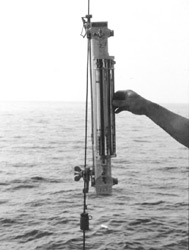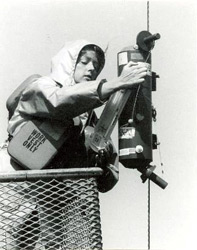Standard Bottle Sampling Depths
Standard depths in meters are:
0 (surface), 10, 20, 30, 50, 75, 100, 125, 150, 200, 250, 300, 400, 500
Additional standard depths when deep casts are performed may include: 600, 700, 800, 900, 1000, 1100, 1200, 1300, 1400, 1500, 1600, 1800, 2000, 2200, 2400, 2600, 2800, 3000, 3200, 3400, 3600...
Bottle Cast-Types: typical bottle depths in meters with 10m-spacing centered around the chlorophyll max, are:
- Type I, chl max < 51m: 0 (~2m, surface), 10, 20, 30, 40, 50, 60, 70, 85, 100, 120, 140, 170, 200, 230, 270, 320, 380, 440, 515
- Type II, chl max 51-120m: 0 (~2m, surface), 10, 25, 40, 50, 62, 75, 87, 100, 112, 125, 140, 165, 200, 230, 270, 320, 380, 440, 515
- Type III, chl max > 120m: 0 (~2m, surface), 20, 40, 60, 80, 100, 110, 120, 130, 140, 150, 160, 175, 195, 230, 270, 320, 380, 440, 515
CalCOFI casts are typically to 515m, with a 3500m deep cast on sta 90.90 (& sometimes 80.90) if ship time & winch wire-length permits.
If additional bottles are available, standard depth bottle spacing can continue at 200m intervals till terminal depth. But normally, due to seawater demands that require duplicate bottle closures, standard level data may be interpolated and/or taken from the CTD sensors.
During the daily primary productivity cast, bottle depths and spacing are based on light level percentages. So shallower bottle depths may not be standard since the target specific, calculated light levels. On casts where bottle closures miss standard depths, data will be interpolated and/or come from the CTD sensors. Refer to the primary productivity methods web page and the table below for more info on the bottle depth determination.
 |
 |
 |
The CalCOFI time-series started in 1949 with scientists clamping ("hanging") Nansen bottles with reversing thermometers on the ship's winch wire, weighted to hang vertically. Twenty bottles were suspended vertically one-by-one at specific spacings to target standard depths, reached once the final bottle was attached and lowered to surface. The spacing between bottles were based on the desired depths, determined by the secchi disc measurement (1% light level).
After waiting 10+ minutes for the thermometers to equilibrate, a messenger (weight) was dropped, initiating a chain-reaction of bottle closures. The first messenger triggered the surface bottle closure which then released a second messenger. The messenger slid down the wire until it struck the second bottle's release mechanism, tripping (closing) the bottle and trapping seawater from that depth. A spring-loaded rack of reversing thermometers that have been acclimating to the temperature at depth, invert 180°, "breaking" the mercury. This 'locked-in' the temperature readings at that depth.
The chain reaction continued and as messengers are released from each of the remaining bottles, the process repeated until the last bottle tripped. After 20 bottles have closed, they were brought back onto the ship and an array of seawater samples were collected from each depth for analysis. Temperatures were read and recorded by two technicians ~45mins later using an illuminated, magnified monocular. Protected and unprotected reversing thermometers were used. This allowed the depths of deeper bottles (>200m) to be calculated by comparing the unprotected vs protected thermometer values.
Over 67+ years the hardware has changed but the basic techniques are still practiced, maintaining the continuity of the time-series. Larger volume PVC bottles with reversing thermometer racks eventually replaced the low-volume, brass Nansen bottles. In 1993, "hanging bottles-on-the-wire" was replaced by a 24-10L bottle CTD-rosette. 20-bottle depth casts are still standard and the 4 extra bottles are used for collecting extra seawater for NCOG, DIC, LTER or primary productivity samples.
Temperatures are measured using precision electronic sensors, replacing the reversing thermometers. Now closing bottles at specific depths is based on the exact chlorophyll max and mixed layer depth, but collecting seawater for ship-board analysis is still performed. Some properties, such as nutrients, DNA, & primary productivity, cannot be measured by electronic sensors yet so seawater collection is still of critical importance to continuing the time-series plus expand the scope of our program.Please note that although bottles 'hung-on-the-wire' were spaced to sample standard depths, their actual reported depth may be slightly different due to wire angle. Protected and unprotected reversing thermometers were used to calculate the true depth of bottles deeper than 200m. In order to report standard depth data on such bottles, measurements were interpolated from adjacent bottles.
Also prior to CTD-rosette usage, two bottle casts were performed on the wire during the daily primary productivity station - a standard depth 20-bottle hydro cast and a second, secchi-based 6-bottle prodo cast. These two casts were tabulated and reported separately in the CalCOFI Data Reports. When the CTD was introduced, the two casts were merged into one, integrating the prodo bottle depths into a standard hydro cast. In order to maintain optimal bottle spacing, all 24 bottles may be used.
Bottles closures using the CTD may also miss standard level depths so 1m binavg corrected CTD temperature, salinity and oxygen data may be reported with interpolated nutrient & chlorophyll data. These "hybrid" standard level data are footnoted accordingly in our data products.
(Historical sidenote before CTD-rosette sampling: a less-used primary productivity practice was to stop the ship during transits between stations at local apparent noon (LAN), do a secchi cast then a 6-bottle prodo cast only. A matching 20-bottle hydro cast may not have been performed. Net tows were also not performed so there may be historical time-series hydrographic data without corresponding net data.)
Typical bottle depth spacing based on downcast fluorescence & mixed layer profiles
| CTD Cast Type I | CTD Cast Type II Mod | Modified Type III | |
| Niskin/Carousel | Fluorescence Max | Fluorescence Max | Fluorescence Max |
| Position # | 0 - 50meters | 50 - 120meters | > 120meters |
| 1 | 515 | 515 | 515 |
| 2 | 440 | 440 | 440 |
| 3 | 380 | 380 | 380 |
| 4 | 320 | 320 | 320 |
| 5 | 270 | 270 | 270 |
| 6 | 230 | 230 | 230 |
| 7 | 200 | 200 | 195 |
| 8 | 170 | 165 | 175 |
| 9 | 140 | 140 | 160 |
| 10 | 120 | 125 | 150 |
| 11 | 100 | 112 | 140 |
| 12 | 85 | 100 | 130 |
| 13 | 70 | 87 | 120 |
| 14 | 60 | 75 | 110 |
| 15 | 50 | 62 | 100 |
| 16 | 40 | 50 | 80 |
| 17 | 30 | 40 | 60 |
| 18 | 20 | 25 | 40 |
| 19 | 10 | 10 | 20 |
| 20 | 0 | 0 | 0 |
| 10m bottle spacing | 12m bottle spacing | 10m bottle spacing | |
| 0 - 70 | 50 - 125 | 100 - 160 | |
| 1st Criteria: | Depth of Fluorescence Maximum during CTD Down Cast | ||
| 2nd Criteria: | Mixed Layer Depth | ||
